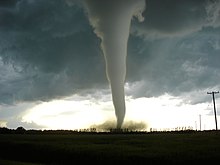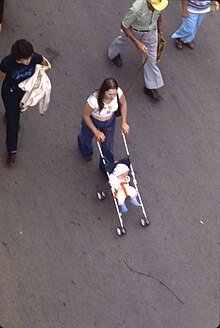User:Abella16/Climate Change, Food Security and Migration in the US
There is a proposed relationship between climate change, food security, and migration.[1] Climate change’s effects on the processing, storage, transportation, and consumption of food as well as on agriculture will diminish food security. Climate change threatens food access and utilization separately as well as the stability of each.[2] The intersection of climate change and food insecurity with ongoing trends in migration is expected to exacerbate these issues.[3] One driver of migration from rural areas to more populated ones is diminishing food security caused by climate change.[1]The increase in climate-induced migration has led to the consideration of policy changes surrounding migration. Climate change and food insecurity affect different demographics in various ways. Several organizations including The World Bank, The World Food Program, and The World Wildlife Fund are working to address the concerns at the intersection of these three issues.
Climate change, food security and migration[edit]
Climate change is becoming an increasing threat to food security. [2] In addition, food security is impacted by several other factors. These include resource-related issues such as land degradation[4] and water security.[5] Alternatively, high prices contribute to food insecurity by creating a barrier to food access for low income individuals.[6] Other environmental issues such as overfishing[7], agricultural disease[8], and pandemics such as Covid-19[9] are also contributors to food insecurity. Additionally, our dependence on fossil fuels has been tied to issues with food security[10].
In roughly three decades, an estimated 143 million people are projected to be forced to migrate due to the effects of climate change.[11]Anyone who has altered the country they live in, regardless of the reason for doing so, is an international migrant, according to the UN. [12]
A major motivator of migration is difficulty accessing food.[13] Alternatively, social and cultural factors can be the cause of migration. This includes changing norms and practices such as the persecution of marginalized groups. New opportunities, the availability of social support networks, family member location, and education can influence migration.[14]

Conflict[edit]
Diminished food security, due to climate change, is a contributor to conflict that is a potential cause of further migration. Food supply is often threatened by increasingly frequent extreme weather events caused by climate change. Often, this is a driver of displacement. An increasing number of competitors for the already-strained supply of natural resources can be a catalyst for disputes and conflict.[3] Food insecurity does not cause conflict alone, but compounds with other factors such as political and economic strains.[16]
A surplus of agricultural products is correlated with increased violence. Characterized as strategic conflict, high rates of output from crops increase the likelihood of violence to access food.[16]
The phases of climate change-induced food insecurity and migration[edit]
The World Food Program USA describes a cycle of climate change and food insecurity containing six phases. In phase one, a climate event occurs. These events include droughts and hurricanes. These are caused by climate change and often occur in areas that have limited resources. Phase two refers to the impacts that occur immediately following the climate change-induced event, such as a flood. These impacts are not limited to the loss of crops, homes, and food supply. In phase three, the supply of food decreases rapidly and prices shoot up. As a result, families consume less food, sell all unnecessary goods, and pull their children out of school. During phase four, crisis hits. Food insecurity erupts, forcing the affected area to become reliant on outside assistance. Food insecurity can drive migration from the affected area.[13] At the same time, some people cannot migrate or choose not to. In phase five the lasting impacts become apparent. This is when overall food consumption falls and malnourishment rises for those who have not migrated. The affected area will experience an increase in the rates of stunting and wasting in children. In addition, the variety of diet diminishes. In phase six, the cycle repeats when another climate change-induced event occurs. At the time of this event, the community is often not recovered from the previous event, exacerbating the harm experienced by the new event.[17]
Migration policy changes[edit]
Climate migrants, many of whom are motivated by food insecurity[13], are changing the way that governments approach migration policy. The discourse surrounding migration policy has historically been rooted in the importance of strict laws and control to deter migration. As climate migration becomes more prevalent, the discourse is shifting from stopping migration and becoming increasingly focused on effectively managing migration.[11] Awareness of food insecurity as a threat to national security is increasing.[16]
Demographic disparities[edit]
Poverty[edit]

Poor communities tend to be the smallest contributors to climate change while simultaneously being affected more than other economic demographics.[19][20] While making up roughly 16% of the world's population, the wealthiest nations are responsible for roughly 40% of CO2 emissions.[20]
Gender[edit]
Globally, other recipients of the most severe impacts of climate change are women and girls. [18]
Disability[edit]
Those with disabilities are also more likely to bear the burden of the impacts of climate change.[21]Globally, food insecurity increases the ill effects on disability-adjusted life years (DALYS). The decrease in DALYs is caused by insufficient micronutrients and protein. This impact is worsened by climate change. Policymakers can use these statistics to determine how they approach efforts to mitigate the effects of climate change and food insecurity.[22]
Migrants[edit]
Migrants are disproportionately impacted by climate change. According to the United Nations High Commissioner for Refugees (UNHCR), the 22 countries that are projected to face the harshest impacts of climate change are currently home to 52% of internationally displaced people.[23]
Potential solutions[edit]
Efforts to mitigate the ill effects at the intersection between climate change, food insecurity, and migration include moving towards climate-smart farming practices and stormproof ponds. In addition, enabling vulnerable populations to lead sustainable lives where they are will lessen the pressure on the environment and our food system.[1]
The World Bank[edit]
The World Bank looks to address the harms at the intersection of climate change, food insecurity, and migration through community-based efforts. Its three areas of focus are empowering communities to take action against climate change, keeping tabs on the social impacts of policies aimed at addressing climate change, and coordinating efforts to understand and mitigate the social impacts of climate change.[24]
Education efforts[edit]

The World Food Program is working to educate communities about agricultural practices that will mitigate the effects of and diminish further contributions to climate change. These strategies include water storage, crop rotation, implementing the growth of crops less susceptible to drought, and decreasing the use of chemicals. Commonly, sustenance farmers previously lacked knowledge about these techniques that would be beneficial to them and the environment. [26]
The "Next California" project[edit]
The World Wildlife Fund is looking to solve the supply challenges posed by climate change by expanding the source of America’s food supply to the Mid-Mississippi Delta Region. The fund is calling this solution the “Next California” Project.[27]
Potential challenges that could arise are due to the differing climates of the two regions. The humidity of the Mississippi Delta brings the challenge of certain pests, necessitating the use of pesticides which makes the process of growing certified organic produce harder. Colder winter temperatures in the Mississippi Delta region eliminate the possibility of growing certain crops.[27]
Additionally, the labor force in the Mississippi Delta is set up in favor of row crops. These crops are harvested via machine, while many crops currently grown in California require people to harvest them. This means the Mississippi Delta is not ready to provide the necessary labor to supply these crops on a large scale.[27]
Further, the infrastructure of the Mississippi Delta is not yet ready to support the storage and preservation required for the national distribution of the food it would supply.[27]
The World Wildlife Fund has suggested the use of workers with H-2A visas to help with the increased need for labor.[27]
References[edit]
- ^ a b c "Climate Change Is A Key Driver of Migration and Food Insecurity". unfccc.int. 2017-09-16. Retrieved 2024-05-07.
- ^ a b Brown, M.E., J.M. Antle, P. Backlund, E.R. Carr, W.E. Easterling, M.K. Walsh, C. Ammann, W. Attavanich, C.B. Barrett, M.F. Bellemare, V. Dancheck, C. Funk, K. Grace, J.S.I. Ingram, H. Jiang, H. Maletta, T. Mata, A. Murray, M. Ngugi, D. Ojima, B. O’Neill, and C. Tebaldi. 2015. Climate Change, Global Food Security, and the U.S. Food System. 146 pages. Available online at http://www.usda.gov/oce/climate_change/FoodSecurity2015Assessment/FullAssessment.pdf.
- ^ a b "How climate change impacts refugees and displaced communities". www.unrefugees.org. Retrieved 2024-05-21.
- ^ "Violent Conflict, Environmental Degradation, and Food Security | Mershon Center". mershoncenter.osu.edu. Retrieved 2024-05-31.
- ^ "Better Water Security Translates into Better Food Security". New Security Beat. 2019-04-08. Retrieved 2024-05-31.
- ^ Gustafson, Daniel J. (September 2013). "Rising food costs & global food security: Key issues & relevance for India". The Indian Journal of Medical Research. 138 (3): 398–410. ISSN 0971-5916. PMC 3818609. PMID 24135190.
- ^ "World Food Day: Overfishing puts both fish and fisheries at risk". wwf.panda.org. Retrieved 2024-05-31.
- ^ Strange, Richard N.; Scott, Peter R. (2005). "Plant disease: a threat to global food security". Annual Review of Phytopathology. 43: 83–116. doi:10.1146/annurev.phyto.43.113004.133839. ISSN 0066-4286. PMID 16078878.
- ^ Kakaei, Hojatollah; Nourmoradi, Heshmatollah; Bakhtiyari, Salar; Jalilian, Mohsen; Mirzaei, Amin (2022). "Effect of COVID-19 on food security, hunger, and food crisis". COVID-19 and the Sustainable Development Goals: 3–29. doi:10.1016/B978-0-323-91307-2.00005-5. PMC 9335023.
- ^ "A food system hooked on fossil fuels is bad for farmers and families". Energy & Climate Intelligence Unit. 2021-10-19. Retrieved 2024-05-31.
- ^ a b "Climate change is already fueling global migration. The world isn't ready to meet people's changing needs, experts say". PBS NewsHour. 2022-07-28. Retrieved 2024-05-07.
- ^ Nations, United. "International migration". United Nations. Retrieved 2024-05-16.
- ^ a b c Semenza, Jan C; Ebi, Kristie L (2019-04-12). "Climate change impact on migration, travel, travel destinations and the tourism industry". Journal of Travel Medicine. 26 (5): taz026. doi:10.1093/jtm/taz026. ISSN 1195-1982. PMC 7107585. PMID 30976790.
- ^ "Drivers of international migration | EMM2". emm.iom.int. Retrieved 2024-05-21.
- ^ "Extreme Weather | USDA Climate Hubs". www.climatehubs.usda.gov. Retrieved 2024-05-21.
- ^ a b c Sova, Chase; Zembilci, Eilish (April 21, 2023). "Dangerously Hungry: The Link between Food Insecurity and Conflict". Center for Strategic & International Studies.
- ^ "Climate Change Is Causing Global Hunger". World Food Program USA. Retrieved 2024-05-07.
- ^ a b "Explainer: How gender inequality and climate change are interconnected". UN Women – Headquarters. 2022-02-28. Retrieved 2024-05-07.
- ^ "The Problem". Climate Refugees. Retrieved 2024-05-07.
- ^ a b "Linking Climate and Inequality". IMF. Retrieved 2024-05-07.
- ^ US EPA, OAR (2022-03-21). "Climate Change and the Health of People with Disabilities". www.epa.gov. Retrieved 2024-05-07.
- ^ Sulser, Timothy B; Beach, Robert H; Wiebe, Keith D; Dunston, Shahnila; Fukagawa, Naomi K (2021-08-01). "Disability-adjusted life years due to chronic and hidden hunger under food system evolution with climate change and adaptation to 2050". The American Journal of Clinical Nutrition. 114 (2): 550–563. doi:10.1093/ajcn/nqab101. ISSN 0002-9165.
- ^ "Climate change". www.who.int. Retrieved 2024-05-21.
- ^ "Social Dimensions of Climate Change". World Bank. Retrieved 2024-05-07.
- ^ "Definition of CROP ROTATION". www.merriam-webster.com. 2024-04-21. Retrieved 2024-05-07.
- ^ "6 Solutions to Climate Change & Hunger". World Food Program USA. Retrieved 2024-05-07.
- ^ a b c d e Korte, Cara (2021-04-21). "Experts say climate change threatens America's food supply. Can farmers in the Mississippi Delta save it? - CBS News". www.cbsnews.com. Retrieved 2024-05-06.
